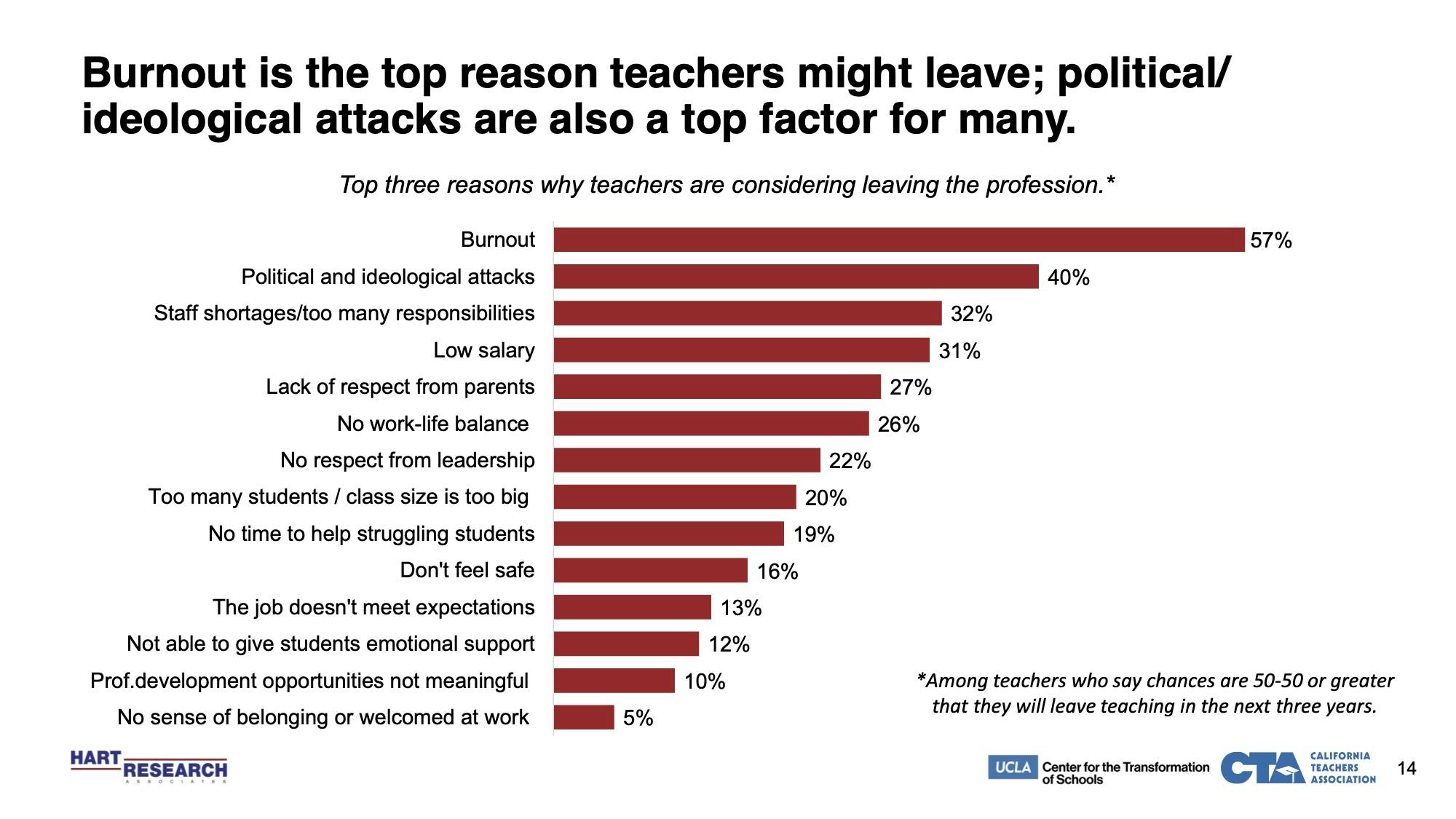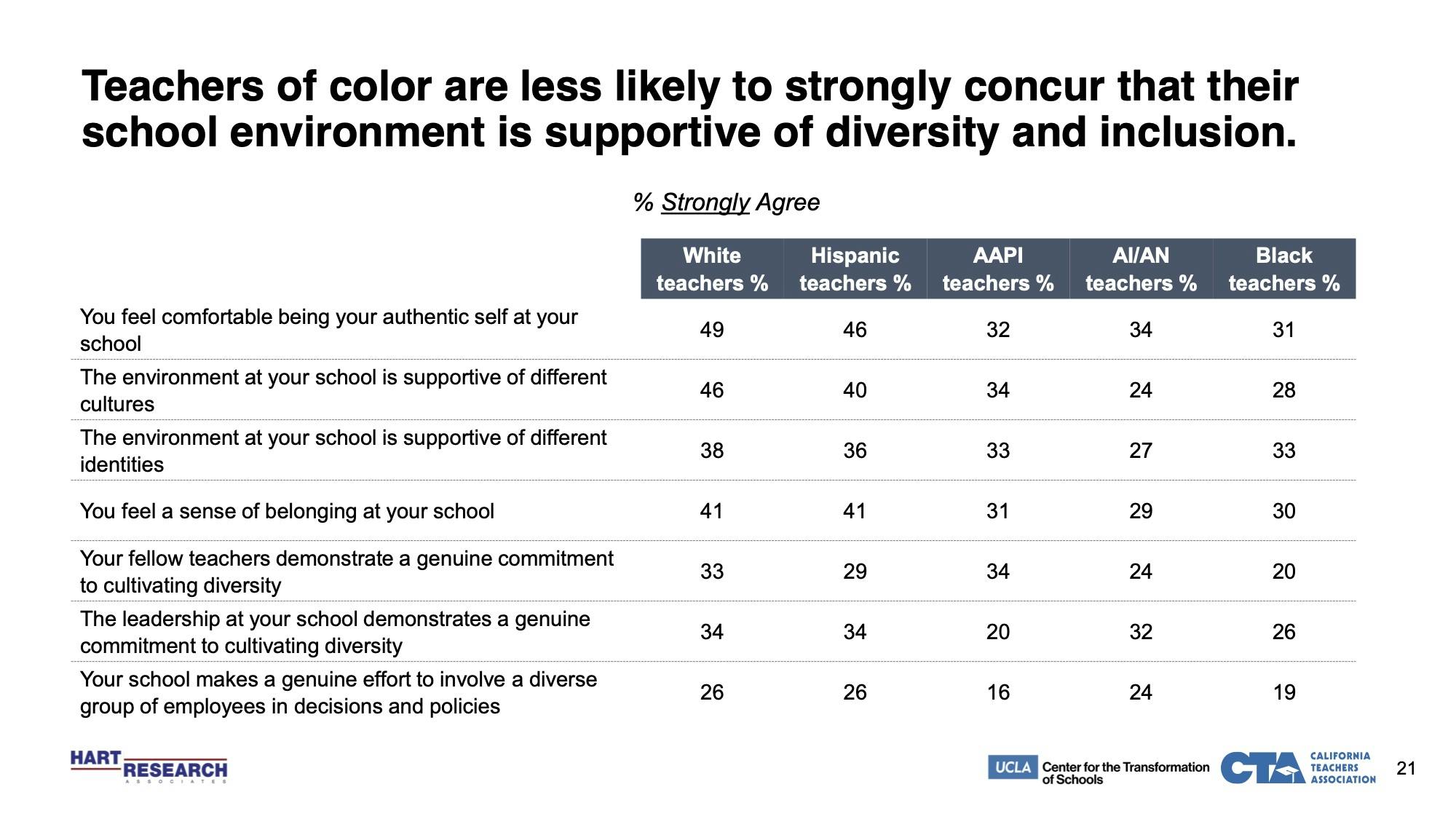Survey of more than 4,600 CA educators published by UCLA Center for the Transformation of Schools and California Teachers Association underscores challenges to California’s teaching workforce. Data highlights need to address issues of diversity and inclusion to attract and retain teachers of color.
A new survey of more than 4,600 current teachers in California finds that while teachers enter the profession to help students and make a difference, many teachers today are feeling acute levels of stress and job dissatisfaction and are considering leaving the profession. As California grapples with an ongoing teacher shortage the findings underscore significant challenges to teacher retention and the recruitment and preparation of aspiring teachers, especially teachers of color.
Published by the UCLA Center for the Transformation of Schools (CTS) and the California Teachers Association (CTA), the report, “Voices from the Classroom: Developing a Strategy for Teacher Retention and Recruitment,” details results from a quantitative survey conducted by Hart Research Associates of 4,632 current TK-12th grade teachers in California.. The report also includes insights from in-depth interviews with former and aspiring teachers who have taught or plan to teach in California.
The survey results reveal alarming findings related to job satisfaction and future outlook, teacher retention, and the need to address diversity & inclusion within the school work environment.
Key among the findings:
Job Satisfaction and Future Outlook
While many current California teachers find their work rewarding and fulfilling, they also feel exhausted and stressed. Teachers were more likely to choose words like “Exhausting” (68%), “Stressful” (61%), “Frustrating” (49%), and “Overwhelming” (51%) to describe how they felt about their current position as a teacher over words like “Rewarding” (34%), “Fulfilling” (29%), “Enjoyable” (22%), and “Empowering” (14%). The majority of respondents expressed low levels of satisfaction with key aspects of their job.
Teacher Retention
Four in ten teachers surveyed said they have considered leaving the profession. Twenty percent (1 in 5) said they will probably or definitely leave the profession within the next three years. Twenty-five percent of Black Teachers say so, more than any other ethnic group.
Burnout from stress (57%) was the top listed reason for leaving the profession. Political and ideological attacks on teachers rank as the second highest reason (40%). Other reasons include workload, low pay, student apathy and behavioral issues, and lack of support from district administrators.
“We’ve reached a tipping point. Teachers are continuously being asked to do more with less,“ said Tyrone Howard, UCLA professor of education and Co-Faculty Director of UCLA’s Center for the Transformation of Schools. “It’s an unfair ask. Our teachers deserve more than what we are giving them.”

Diversity & Inclusion Within the School Work Environment
Many current teachers of color, especially Black teachers said they have experienced discrimination and do not feel comfortable expressing themselves at their school site. Aspiring and former teachers who are people of color share that feeling comfortable and a part of their school community was directly tied to whether their students and their families, peers, and leadership had similar racial/ethnic backgrounds to their own. While more than half of white teachers expressed high satisfaction that their work environment is free of discrimination and prejudice, the percentage falls below 50 percent for teachers of color. Just 36 percent of Black teachers said that was the case at their school. Additionally, more than six out of ten Black teachers (62%) and half of Asian-American/Pacific Islander (54%) teachers surveyed said they have experienced racial discrimination in their current position.
Less than half of teachers strongly agreed that the environment at their school is supportive of different cultures (41%) and different identities (36%). Only 31% believe that their fellow teachers demonstrate a genuine commitment to cultivating diversity. Four in ten LGBTQ+ teachers reported discrimination based on their sexual orientation in their current teaching position.

“If we want to attract and retain a diverse teacher workforce, our schools and working environments have to do better at accommodating diversity,” said Kai Mathews, CA Educator Diversity Project Director for the UCLA Center for the Transformation of Schools and researcher on the project. “We have a tendency to think that diversity begins and ends with the demographics of a population, but we know that diversity efforts either succeed or fail based on the accessibility and inclusivity of an organization’s culture.
“It seems like we are trying to gather people and bring them to schools and call it diversity, without preparing schools to welcome diversity. Even if we had a big influx of teachers of color, if we can’t provide them with a workplace environment where they feel welcome, where they feel connected and their culture is valued and respected, it’s only going to get harder to recruit and retain the teachers we need.
“And If a quarter of Black teachers are saying they are planning to leave in three-years, we cannot and should not discount how they are feeling about their racialized experiences and how those feelings may shape their decision to leave the profession,” Mathews said.
Teacher Preparation Programs
Aspiring teachers provided insights on teacher preparation programs, including the importance of real-time teaching experiences and concerns about the workload and required state teacher assessments. Compensating student teachers was suggested by a significant number of the aspiring teachers and is viewed as a very important policy change that will help alleviate financial stress at an important time in the teacher preparation process. Eighteen out of 25 aspiring teachers stated that financial costs influenced their ability to finish the teacher preparation program.
Practices and Policies to Improve Teacher Retention
More than 88% of teachers identified better pay as the top priority state and local officials should prioritize in order to improve teacher retention, followed by smaller class sizes, stronger discipline policies for students who behave disruptively, better staffing, a more manageable workload and more support services for students. The majority (80%) of teachers surveyed said it is difficult to find affordable housing near their place of employment, while 68% said it is difficult for them to keep up with basic expenses and the cost of living, and to save for retirement. Former teachers expressed concerns regarding classroom and relationship management and indicated a desire for more professional opportunities for teachers (especially those who are newer to the field) to learn relationship-based skill sets to manage interactions with students and other teachers, administrators and parents.
Voices from the Classroom: Developing a Strategy for Teacher Retention and Recruitment is a project of the UCLA Center for the Transformation of Schools and the California Teachers Association. Funding for the research has been provided by the Bill & Melinda Gates Foundation and the William & Flora Hewlett Foundation. The report, including an executive summary, can be found online at https://transformschools.ucla.edu/voices-from-the-classroom/
